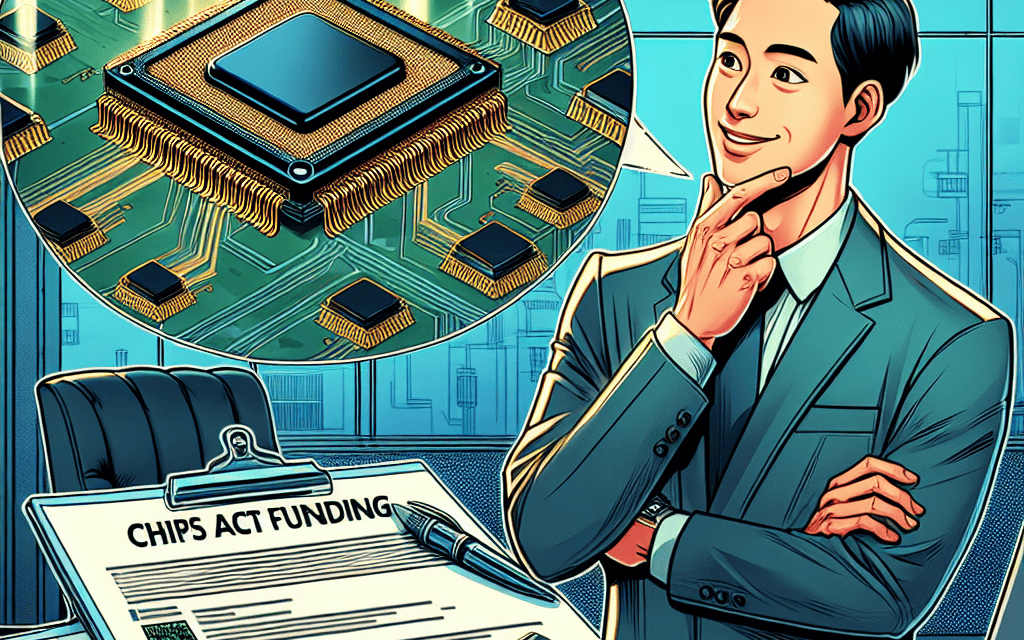“Intel CEO Applauds TSMC’s Innovation, Anticipates Boost from CHIPS Act Funding”
Introduction
Intel CEO Pat Gelsinger has recently expressed commendation for Taiwan Semiconductor Manufacturing Company (TSMC), highlighting the company’s pivotal role in the global semiconductor industry. As Intel continues to navigate the competitive landscape of chip manufacturing, Gelsinger’s acknowledgment underscores the importance of collaboration and innovation within the sector. Meanwhile, Intel is also keenly anticipating the allocation of funds from the CHIPS Act, a U.S. government initiative aimed at bolstering domestic semiconductor production and research. The funding is expected to enhance Intel’s capabilities and competitiveness, further solidifying its position in the market. Gelsinger’s remarks come at a time when the semiconductor industry is facing unprecedented demand and challenges, making strategic partnerships and government support more crucial than ever.
Intel CEO’s Strategic Praise for TSMC: A New Era of Collaboration
In a rapidly evolving semiconductor industry, collaboration and strategic partnerships have become essential for companies aiming to maintain a competitive edge. Intel CEO Pat Gelsinger’s recent commendation of Taiwan Semiconductor Manufacturing Company (TSMC) underscores this trend, highlighting a potential shift towards greater cooperation between industry giants. Gelsinger’s praise for TSMC, a leader in advanced chip manufacturing, is not merely a gesture of goodwill but a strategic acknowledgment of the critical role TSMC plays in the global semiconductor supply chain. This recognition comes at a time when Intel is navigating its own transformation, seeking to reclaim its position as a leader in chip manufacturing while also expanding its foundry services.
The semiconductor industry is characterized by its complexity and the interdependence of its players. TSMC’s prowess in producing cutting-edge chips has made it an indispensable partner for many technology companies worldwide. By acknowledging TSMC’s contributions, Gelsinger is signaling Intel’s openness to collaboration, which could pave the way for future partnerships that leverage the strengths of both companies. This approach aligns with Intel’s broader strategy to diversify its manufacturing capabilities and enhance its technological offerings.
Moreover, Gelsinger’s remarks come at a pivotal moment as Intel awaits funding from the CHIPS Act, a U.S. government initiative aimed at bolstering domestic semiconductor manufacturing. The CHIPS Act represents a significant opportunity for Intel to accelerate its manufacturing expansion plans within the United States. By securing this funding, Intel aims to enhance its production capabilities, reduce reliance on foreign manufacturing, and contribute to the resilience of the U.S. semiconductor supply chain. The potential collaboration with TSMC could further complement these efforts, allowing Intel to tap into TSMC’s expertise and advanced manufacturing processes.
The CHIPS Act funding is crucial for Intel’s ambitious plans to build new fabrication plants, or fabs, in the United States. These facilities are expected to play a vital role in meeting the growing demand for semiconductors, which are essential components in a wide range of industries, from consumer electronics to automotive and beyond. As Intel positions itself to take advantage of this funding, the company’s strategic praise for TSMC may also serve to reassure stakeholders of its commitment to fostering a collaborative ecosystem that benefits the entire industry.
Furthermore, the potential collaboration between Intel and TSMC could have far-reaching implications for the global semiconductor landscape. By working together, these industry leaders could drive innovation, improve supply chain resilience, and address the challenges posed by the increasing complexity of chip design and manufacturing. This partnership could also set a precedent for other companies in the industry, encouraging a more cooperative approach to addressing common challenges and advancing technological progress.
In conclusion, Intel CEO Pat Gelsinger’s praise for TSMC is a strategic move that reflects the evolving dynamics of the semiconductor industry. As Intel awaits CHIPS Act funding, the potential for collaboration with TSMC represents an opportunity to strengthen its manufacturing capabilities and contribute to a more resilient and innovative semiconductor ecosystem. By embracing collaboration, Intel is positioning itself to navigate the challenges and opportunities of the future, ultimately benefiting not only the company but the industry as a whole.
The Impact of CHIPS Act Funding on Intel’s Future Plans
In recent developments within the semiconductor industry, Intel’s CEO has expressed commendation for Taiwan Semiconductor Manufacturing Company (TSMC), highlighting the pivotal role it plays in the global supply chain. This acknowledgment comes at a time when Intel is eagerly anticipating the disbursement of funds from the CHIPS Act, a legislative initiative aimed at bolstering the United States’ semiconductor manufacturing capabilities. The CHIPS Act, formally known as the Creating Helpful Incentives to Produce Semiconductors for America Act, is designed to address the growing concerns over semiconductor shortages and the increasing reliance on foreign manufacturing. As Intel positions itself to capitalize on this funding, the company’s future plans are intricately tied to the successful implementation of this legislation.
Intel’s CEO has underscored the importance of TSMC, not only as a competitor but also as a crucial partner in the semiconductor ecosystem. This recognition is significant, considering the competitive dynamics between the two companies. TSMC’s advanced manufacturing processes and technological prowess have set a high benchmark in the industry, compelling Intel to innovate and enhance its own capabilities. By acknowledging TSMC’s contributions, Intel is signaling a collaborative approach, which could foster a more resilient and interconnected global semiconductor supply chain.
The anticipation surrounding the CHIPS Act funding is palpable within Intel, as the company seeks to expand its manufacturing footprint in the United States. The funding is expected to provide substantial support for Intel’s ambitious plans to build new fabrication plants, or fabs, which are essential for increasing domestic production capacity. This expansion is not only crucial for meeting the growing demand for semiconductors but also for reducing the dependency on overseas manufacturing, which has been a point of vulnerability highlighted by recent supply chain disruptions.
Moreover, the CHIPS Act funding is poised to accelerate Intel’s research and development efforts, enabling the company to push the boundaries of semiconductor technology. By investing in cutting-edge research, Intel aims to maintain its competitive edge and drive innovation in areas such as artificial intelligence, 5G, and autonomous vehicles. These advancements are expected to have far-reaching implications, not only for Intel but for the broader technology landscape, as semiconductors are the backbone of modern digital infrastructure.
In addition to bolstering Intel’s manufacturing and R&D capabilities, the CHIPS Act funding is anticipated to have a positive impact on the U.S. economy. The construction of new fabs is projected to create thousands of jobs, both directly and indirectly, contributing to economic growth and technological leadership. Furthermore, by strengthening the domestic semiconductor industry, the United States can enhance its national security, ensuring a stable and reliable supply of critical components for various sectors, including defense and telecommunications.
As Intel awaits the allocation of CHIPS Act funds, the company remains committed to its strategic vision of becoming a leader in semiconductor manufacturing. The collaboration with industry partners, coupled with government support, is expected to propel Intel towards achieving its goals. While challenges remain, particularly in navigating the complexities of global supply chains and technological advancements, the CHIPS Act represents a significant step forward in securing a robust and sustainable future for Intel and the semiconductor industry as a whole. Through strategic investments and partnerships, Intel is poised to play a pivotal role in shaping the next era of technological innovation.
How Intel’s Relationship with TSMC Could Reshape the Semiconductor Industry
In the rapidly evolving landscape of the semiconductor industry, strategic partnerships and government support are becoming increasingly crucial. Intel’s CEO, Pat Gelsinger, has recently underscored the importance of these elements by praising Taiwan Semiconductor Manufacturing Company (TSMC) and expressing anticipation for the funding from the CHIPS Act. This dual focus on collaboration and legislative support highlights a transformative period for Intel and the broader semiconductor sector.
Intel, a stalwart in the semiconductor industry, has long been recognized for its innovation and manufacturing prowess. However, the company has faced significant challenges in recent years, including increased competition and production delays. In response, Intel has embarked on a strategic pivot, emphasizing collaboration with other industry leaders like TSMC. This partnership is not merely a tactical maneuver but a strategic alignment that could reshape the semiconductor landscape. By leveraging TSMC’s advanced manufacturing capabilities, Intel aims to enhance its product offerings and accelerate its technological advancements.
TSMC, the world’s largest contract chipmaker, has established itself as a pivotal player in the semiconductor industry. Its cutting-edge technology and efficient production processes have made it an attractive partner for companies like Intel, which are seeking to maintain their competitive edge. Gelsinger’s commendation of TSMC underscores the mutual benefits of this collaboration. By working together, Intel and TSMC can pool their resources and expertise, potentially leading to groundbreaking innovations and more robust supply chains.
While the partnership with TSMC is a significant step forward, Intel’s future also hinges on the successful implementation of the CHIPS Act. This legislation, designed to bolster domestic semiconductor manufacturing, promises substantial funding to support the industry’s growth. Gelsinger has expressed optimism about the potential impact of this funding, which could provide Intel with the necessary resources to expand its manufacturing capabilities in the United States. The CHIPS Act represents a critical opportunity for Intel to strengthen its position in the global market and reduce reliance on overseas production.
The intersection of Intel’s collaboration with TSMC and the anticipated CHIPS Act funding could have far-reaching implications for the semiconductor industry. By aligning with TSMC, Intel is not only enhancing its technological capabilities but also setting a precedent for cross-border partnerships in the sector. This collaboration could encourage other companies to pursue similar alliances, fostering a more interconnected and resilient industry.
Moreover, the CHIPS Act funding could catalyze a renaissance in American semiconductor manufacturing. By investing in domestic production, the United States can mitigate supply chain vulnerabilities and ensure a steady supply of critical components. This shift could also stimulate job creation and economic growth, reinforcing the country’s position as a leader in technological innovation.
In conclusion, Intel’s strategic partnership with TSMC and the anticipated support from the CHIPS Act represent pivotal developments in the semiconductor industry. These initiatives underscore the importance of collaboration and government support in navigating the challenges of a rapidly changing market. As Intel and TSMC work together to push the boundaries of technology, the semiconductor industry stands on the brink of a new era, characterized by innovation, resilience, and global cooperation. The coming years will reveal the full impact of these efforts, potentially reshaping the industry and setting new standards for excellence and collaboration.
Analyzing the Implications of Intel’s Support for TSMC
In a recent development that has captured the attention of the semiconductor industry, Intel’s CEO has publicly praised Taiwan Semiconductor Manufacturing Company (TSMC), highlighting the critical role it plays in the global supply chain. This endorsement comes at a time when Intel is eagerly awaiting the disbursement of funds from the CHIPS Act, a U.S. government initiative aimed at bolstering domestic semiconductor manufacturing. The intersection of these two events offers a fascinating glimpse into the strategic maneuvers within the semiconductor sector, as well as the broader geopolitical implications.
Intel’s commendation of TSMC is noteworthy, given the competitive dynamics between the two companies. Historically, Intel has been a dominant player in the semiconductor industry, renowned for its cutting-edge technology and manufacturing prowess. However, in recent years, TSMC has emerged as a formidable competitor, particularly in the realm of advanced chip manufacturing. By acknowledging TSMC’s contributions, Intel’s CEO is not only recognizing the Taiwanese company’s technological advancements but also underscoring the importance of collaboration in an increasingly interconnected global market.
This gesture of goodwill towards TSMC can be seen as a strategic move by Intel, as it seeks to navigate the complexities of the semiconductor landscape. The global chip shortage has underscored the vulnerabilities in the supply chain, prompting companies and governments alike to reassess their strategies. In this context, Intel’s support for TSMC may be interpreted as an acknowledgment of the need for a diversified and resilient supply chain, one that leverages the strengths of multiple players to ensure stability and innovation.
Simultaneously, Intel’s anticipation of CHIPS Act funding highlights the company’s commitment to expanding its manufacturing capabilities within the United States. The CHIPS Act, which was enacted to incentivize domestic semiconductor production, represents a significant investment in the U.S. technology sector. For Intel, securing this funding is crucial to its plans for building new fabrication facilities, or fabs, which are essential for maintaining its competitive edge and reducing reliance on overseas manufacturing.
The interplay between Intel’s support for TSMC and its pursuit of CHIPS Act funding reflects a broader trend in the semiconductor industry: the balancing act between competition and collaboration. While companies vie for market share and technological supremacy, there is also a growing recognition of the benefits of strategic partnerships. By fostering relationships with key players like TSMC, Intel can enhance its own capabilities while contributing to a more robust and secure global supply chain.
Moreover, the implications of these developments extend beyond the corporate sphere, touching on geopolitical considerations. The semiconductor industry is a critical component of national security, and the U.S. government’s efforts to bolster domestic production are driven by concerns over supply chain vulnerabilities and technological leadership. Intel’s actions, therefore, are not only a reflection of its business strategy but also a response to the evolving geopolitical landscape.
In conclusion, Intel’s praise for TSMC and its anticipation of CHIPS Act funding illustrate the complex dynamics at play in the semiconductor industry. As companies navigate the challenges of competition, collaboration, and geopolitical pressures, their strategies will shape the future of technology and innovation. The unfolding narrative of Intel and TSMC serves as a microcosm of the broader shifts occurring within this vital sector, offering valuable insights into the forces driving change in the global economy.
The Role of the CHIPS Act in Strengthening U.S. Semiconductor Manufacturing
In recent years, the semiconductor industry has become a focal point of global economic strategy, with nations vying to secure their positions in this critical sector. The United States, recognizing the strategic importance of semiconductor manufacturing, has introduced the CHIPS Act, a legislative initiative aimed at bolstering domestic production capabilities. Intel CEO Pat Gelsinger has been vocal in his support for this initiative, emphasizing its potential to revitalize the U.S. semiconductor industry. In a recent statement, Gelsinger also praised Taiwan Semiconductor Manufacturing Company (TSMC) for its leadership and innovation in the field, highlighting the collaborative spirit necessary to advance technological progress.
The CHIPS Act, formally known as the Creating Helpful Incentives to Produce Semiconductors for America Act, is designed to provide substantial funding and incentives to semiconductor manufacturers operating within the United States. This legislation is seen as a critical step in reducing dependency on foreign semiconductor production, particularly in light of recent global supply chain disruptions. By fostering a robust domestic semiconductor industry, the U.S. aims to enhance its technological sovereignty and economic resilience.
Gelsinger’s commendation of TSMC underscores the importance of international cooperation in the semiconductor industry. TSMC, a global leader in semiconductor manufacturing, has set benchmarks in innovation and efficiency that other companies aspire to reach. By acknowledging TSMC’s achievements, Gelsinger highlights the necessity of learning from and collaborating with global leaders to drive the industry forward. This perspective aligns with the broader vision of the CHIPS Act, which seeks not only to strengthen U.S. capabilities but also to foster a competitive and innovative global semiconductor ecosystem.
While the CHIPS Act holds promise, its success hinges on timely and effective implementation. Gelsinger has expressed anticipation for the disbursement of funds, which will be crucial in accelerating Intel’s plans to expand its manufacturing footprint in the United States. The funding is expected to support the construction of new fabrication facilities, or fabs, which are essential for increasing production capacity and meeting the growing demand for semiconductors. These investments are anticipated to create thousands of jobs and stimulate economic growth in regions hosting these facilities.
Moreover, the CHIPS Act is poised to address the talent gap in the semiconductor industry by supporting workforce development initiatives. By investing in education and training programs, the legislation aims to equip the next generation of engineers and technicians with the skills necessary to thrive in this rapidly evolving field. This focus on human capital is critical, as the industry’s growth is contingent upon a skilled and adaptable workforce.
In conclusion, the CHIPS Act represents a strategic effort to fortify the U.S. semiconductor industry, with Intel CEO Pat Gelsinger’s remarks highlighting both the challenges and opportunities that lie ahead. By praising TSMC, Gelsinger acknowledges the importance of global collaboration in advancing semiconductor technology. As the industry awaits the allocation of CHIPS Act funding, the focus remains on building a resilient and innovative semiconductor ecosystem that can meet the demands of the future. Through strategic investments and international cooperation, the U.S. aims to secure its position as a leader in this vital industry, ensuring economic stability and technological advancement for years to come.
Intel’s Vision for the Future: Balancing Competition and Collaboration
In the rapidly evolving landscape of semiconductor manufacturing, Intel’s CEO, Pat Gelsinger, has recently highlighted the importance of both competition and collaboration in driving the industry forward. As Intel navigates its ambitious roadmap for technological advancement, Gelsinger has notably praised Taiwan Semiconductor Manufacturing Company (TSMC) for its pivotal role in the global semiconductor ecosystem. This acknowledgment underscores a nuanced approach where Intel recognizes the value of its competitors while simultaneously striving to reclaim its leadership position in chip manufacturing.
TSMC, a dominant force in the semiconductor industry, has set benchmarks in innovation and efficiency that have compelled other companies, including Intel, to elevate their game. Gelsinger’s commendation of TSMC is not merely a gesture of goodwill but a strategic acknowledgment of the competitive landscape that necessitates collaboration. By recognizing TSMC’s contributions, Intel positions itself as a company that values the collective progress of the industry, understanding that advancements by one player can drive the entire sector forward.
However, Intel’s vision for the future is not solely reliant on external partnerships. The company is actively pursuing its own path to innovation, with plans to expand its manufacturing capabilities and invest in cutting-edge technologies. Central to this strategy is the anticipated funding from the CHIPS Act, a U.S. government initiative designed to bolster domestic semiconductor production. The CHIPS Act represents a significant opportunity for Intel to enhance its manufacturing infrastructure, reduce dependency on foreign supply chains, and ultimately strengthen its competitive edge.
While awaiting the disbursement of CHIPS Act funding, Intel is already laying the groundwork for its future endeavors. The company has announced plans to build new fabrication plants, or fabs, in the United States, which will not only increase its production capacity but also create thousands of jobs. These initiatives are part of Intel’s broader strategy to revitalize its manufacturing prowess and ensure that it remains at the forefront of semiconductor innovation.
In this context, the balance between competition and collaboration becomes even more critical. Intel’s relationship with TSMC exemplifies how companies can compete fiercely in certain areas while collaborating in others to achieve mutual benefits. For instance, Intel has outsourced some of its chip production to TSMC, leveraging the latter’s advanced manufacturing processes to meet market demands. This pragmatic approach allows Intel to focus on its core strengths while benefiting from TSMC’s expertise.
Moreover, the semiconductor industry is facing unprecedented challenges, including supply chain disruptions and geopolitical tensions. In such a volatile environment, collaboration among industry leaders is essential to ensure stability and resilience. By fostering partnerships and maintaining open lines of communication, companies like Intel and TSMC can navigate these challenges more effectively, ensuring the continued growth and innovation of the sector.
In conclusion, Intel’s vision for the future is characterized by a delicate balance between competition and collaboration. By acknowledging the strengths of its competitors and investing in its own capabilities, Intel is positioning itself to thrive in an increasingly complex and interconnected world. As the company awaits the crucial funding from the CHIPS Act, it remains committed to advancing the semiconductor industry, recognizing that the path to success lies in both individual excellence and collective progress.
The Significance of Intel’s Endorsement of TSMC in Global Tech Dynamics
In the rapidly evolving landscape of global technology, the interplay between major industry players often shapes the future of innovation and economic growth. Recently, Intel’s CEO, Pat Gelsinger, made headlines by publicly praising Taiwan Semiconductor Manufacturing Company (TSMC), a move that underscores the intricate dynamics of the semiconductor industry. This endorsement is not merely a gesture of goodwill but a strategic acknowledgment of TSMC’s pivotal role in the global supply chain. As the world’s largest contract chipmaker, TSMC has been instrumental in advancing semiconductor technology, which is foundational to a myriad of industries, from consumer electronics to automotive manufacturing.
Intel’s commendation of TSMC comes at a time when the semiconductor industry is grappling with unprecedented challenges, including supply chain disruptions and geopolitical tensions. By recognizing TSMC’s contributions, Intel is not only highlighting the importance of collaboration but also signaling a potential shift towards more cooperative strategies among tech giants. This is particularly significant as the industry seeks to navigate the complexities of global supply chains and the increasing demand for advanced chips. Moreover, Intel’s acknowledgment may also be seen as a strategic move to foster goodwill and potentially explore future partnerships that could benefit both companies in the long run.
Simultaneously, Intel is eagerly awaiting the disbursement of funds from the CHIPS Act, a U.S. government initiative aimed at bolstering domestic semiconductor manufacturing. The act, which stands for Creating Helpful Incentives to Produce Semiconductors, represents a critical step in addressing the vulnerabilities exposed by the recent chip shortages. By investing in domestic production capabilities, the U.S. aims to reduce its reliance on foreign manufacturers and enhance its technological sovereignty. For Intel, the CHIPS Act funding is not just a financial boon but a crucial component of its strategy to regain leadership in semiconductor manufacturing.
The intersection of Intel’s praise for TSMC and its anticipation of CHIPS Act funding highlights the dual approach the company is taking to navigate the current technological landscape. On one hand, Intel is acknowledging the indispensable role of global partners like TSMC, which is essential for maintaining a resilient supply chain. On the other hand, it is also focusing on strengthening its domestic capabilities to ensure long-term competitiveness and innovation. This balanced approach reflects a broader industry trend where collaboration and self-reliance are not mutually exclusive but rather complementary strategies.
Furthermore, Intel’s actions are indicative of a larger shift in the global tech ecosystem, where companies are increasingly recognizing the need for both international cooperation and domestic investment. As the semiconductor industry continues to evolve, the ability to adapt to these dual imperatives will likely determine the success of major players. The endorsement of TSMC, coupled with the anticipation of CHIPS Act funding, positions Intel at the forefront of this transformation, poised to leverage both global partnerships and national resources.
In conclusion, Intel’s recent moves underscore the significance of strategic alliances and government support in shaping the future of the semiconductor industry. By praising TSMC and awaiting CHIPS Act funding, Intel is navigating a complex landscape with a nuanced approach that balances collaboration with self-sufficiency. As the industry continues to face challenges and opportunities, such strategies will be crucial in driving innovation and ensuring sustainable growth in the global tech arena.
Q&A
1. **What did the Intel CEO praise TSMC for?**
The Intel CEO praised TSMC for its advanced semiconductor manufacturing capabilities and its role in the global supply chain.
2. **Why is the CHIPS Act funding important for Intel?**
The CHIPS Act funding is important for Intel as it aims to boost domestic semiconductor manufacturing, which would support Intel’s efforts to expand its production capabilities in the United States.
3. **What is the CHIPS Act?**
The CHIPS Act is a legislative initiative in the United States designed to provide funding and incentives to increase semiconductor manufacturing and research within the country.
4. **How does Intel view its relationship with TSMC?**
Intel views its relationship with TSMC as collaborative, recognizing TSMC’s expertise and contributions to the semiconductor industry while also competing in certain areas.
5. **What are the expected benefits of the CHIPS Act for the semiconductor industry?**
The expected benefits include increased domestic production capacity, reduced dependency on foreign manufacturing, and enhanced innovation and competitiveness in the semiconductor industry.
6. **What challenges does Intel face without CHIPS Act funding?**
Without CHIPS Act funding, Intel may face challenges in scaling up its manufacturing operations in the U.S., potentially impacting its competitiveness and ability to meet growing demand.
7. **How does the Intel CEO view the future of semiconductor manufacturing?**
The Intel CEO is optimistic about the future of semiconductor manufacturing, emphasizing the importance of strategic investments and partnerships to drive innovation and meet global demand.
Conclusion
Intel CEO Pat Gelsinger has expressed admiration for Taiwan Semiconductor Manufacturing Company (TSMC), acknowledging its significant role in the semiconductor industry. He emphasized the importance of collaboration and competition in driving technological advancements. Gelsinger also highlighted the critical need for the CHIPS Act funding to bolster domestic semiconductor manufacturing in the United States. The funding is seen as essential for enhancing supply chain resilience, fostering innovation, and maintaining global competitiveness. As Intel seeks to expand its manufacturing capabilities, the CHIPS Act support is anticipated to play a pivotal role in achieving these strategic objectives.





